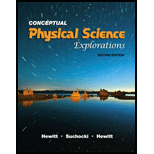
Which is stronger: the covalent bond that holds atoms together within a molecule or the electrical attraction between two neighbouring molecules?
Whether the covalent bond or electrical attractions is stronger.
Answer to Problem 16TE
The covalent bond is stronger as it has the overlapping of orbitals as compared to the electronic attraction between the molecules.
Explanation of Solution
A covalent bond is a bond formed by sharing of electrons between the atoms having very less electronegativity difference. The number of unpaired valence electrons in the valence shell undergoes electron interaction to form a covalent bond. The covalent bond is specifically formed by the overlapping of orbitals to share the electrons between the two atoms.
The electrical attraction between the molecules is just the extra amount of forces called a intermolecular Attractive forces. They are very weak types of forces present between the molecules.
Thus, the covalent bond is stronger as it has the overlapping of orbitals as compared to the electronic attraction between the molecules.
Conclusion:
Therefore, the covalent bond is stronger as it has the overlapping of orbitals as compared to the electronic attraction between the molecules
Chapter 18 Solutions
Conceptual Physical Science Explorations
Additional Science Textbook Solutions
Life in the Universe (4th Edition)
Essential University Physics: Volume 2 (3rd Edition)
Glencoe Physical Science 2012 Student Edition (Glencoe Science) (McGraw-Hill Education)
Introduction to Electrodynamics
Physics: Principles with Applications
Applied Physics (11th Edition)
 College PhysicsPhysicsISBN:9781305952300Author:Raymond A. Serway, Chris VuillePublisher:Cengage Learning
College PhysicsPhysicsISBN:9781305952300Author:Raymond A. Serway, Chris VuillePublisher:Cengage Learning University Physics (14th Edition)PhysicsISBN:9780133969290Author:Hugh D. Young, Roger A. FreedmanPublisher:PEARSON
University Physics (14th Edition)PhysicsISBN:9780133969290Author:Hugh D. Young, Roger A. FreedmanPublisher:PEARSON Introduction To Quantum MechanicsPhysicsISBN:9781107189638Author:Griffiths, David J., Schroeter, Darrell F.Publisher:Cambridge University Press
Introduction To Quantum MechanicsPhysicsISBN:9781107189638Author:Griffiths, David J., Schroeter, Darrell F.Publisher:Cambridge University Press Physics for Scientists and EngineersPhysicsISBN:9781337553278Author:Raymond A. Serway, John W. JewettPublisher:Cengage Learning
Physics for Scientists and EngineersPhysicsISBN:9781337553278Author:Raymond A. Serway, John W. JewettPublisher:Cengage Learning Lecture- Tutorials for Introductory AstronomyPhysicsISBN:9780321820464Author:Edward E. Prather, Tim P. Slater, Jeff P. Adams, Gina BrissendenPublisher:Addison-Wesley
Lecture- Tutorials for Introductory AstronomyPhysicsISBN:9780321820464Author:Edward E. Prather, Tim P. Slater, Jeff P. Adams, Gina BrissendenPublisher:Addison-Wesley College Physics: A Strategic Approach (4th Editio...PhysicsISBN:9780134609034Author:Randall D. Knight (Professor Emeritus), Brian Jones, Stuart FieldPublisher:PEARSON
College Physics: A Strategic Approach (4th Editio...PhysicsISBN:9780134609034Author:Randall D. Knight (Professor Emeritus), Brian Jones, Stuart FieldPublisher:PEARSON





